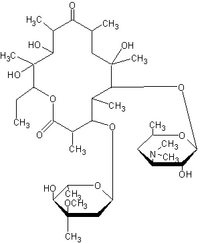Definition
Nocardiosis is a serious infection caused by a fungus-like bacterium that begins in the lungs and can spread to the brain.
Description
Nocardiosis is found throughout the world among people of all ages, although it is most common in older people and males. While people with poor immunity are vulnerable to this infection, it sometimes strikes individuals with no history of other diseases. Nocardiosis is rare in AIDS patients. It is not transmitted by person-to-person contact.
Causes & symptoms
Nocardiosis is caused by a bacterium of the Nocardia species--usually N. asteroides, an organism that is normally found in the soil. The incubation period is not known, but is probably several weeks.
The bacteria can enter the human body when a person inhales contaminated dust. Less often, people can pick up the bacteria in contaminated puncture wounds or cuts.
Symptoms
The infection causes a cough similar to pneumonia or tuberculosis, producing thick, sometimes bloody, sputum. Other symptoms include chills, night sweats, chest pain, weakness, loss of appetite and weight loss. Nocardiosis does not, however, respond to short-term antibiotics.
Complications
In about one-third of patients, the infection spreads from the blood into the brain, causing brain abscesses. This complication can trigger a range of symptoms including severe headache, confusion, disorientation, dizziness, nausea and seizures, and problems in walking. If a brain abscess ruptures, it can lead to meningitis.
About a third of patients with nocardiosis also have abscesses in the skin or directly underneath the skin. They may also have lesions in other organs, such as the kidneys, liver, or bones.
Diagnosis
Nocardia is not easily identified from cultures of sputum or discharge. A doctor can diagnose the condition using special staining techniques and taking a thorough medical history. Lung biopsies or x-rays also may be required. Up to 40% of the time, however, a diagnosis can't be made until an autopsy is done.
Treatment
Treatment of nocardiosis includes bed rest and high doses of medication for a period of 12 to 18 months, including sulfonamide drugs or a combination of trimethoprim-sulfamethoxazole (Bactrim, Septra). If the patient doesn't respond to these drugs, antibiotics such as ampicillin (Amcill, Principen) or erythromycin (E-Mycin, Eryc) may be tried.
The abscesses may need to be drained and dead tissue cut away. Other symptoms are treated as necessary.
Prognosis
Nocardiosis is a serious disease with a high mortality rate. If it has been diagnosed early and caught before spreading to the brain, the prognosis is better. Even with appropriate treatment, however, the death rate is still 50%. Once the infection reaches the brain, the death rate is above 80%. This outcome is most commonly seen in patients with a weakened immune system.
Key Terms
- Abscess
- A localized area of infection in a body tissue. Abscesses in the brain or skin are possible complications of nocardiosis.
- Meningitis
- An infection of the outer covering of the brain (meninges) that can be caused by either bacteria or a virus.
Further Reading
For Your Information
Books
- Handbook of Diseases, edited by June Norris. Springhouse, PA: Springhouse Corp., 1996.
Gale Encyclopedia of Medicine. Gale Research, 1999.



